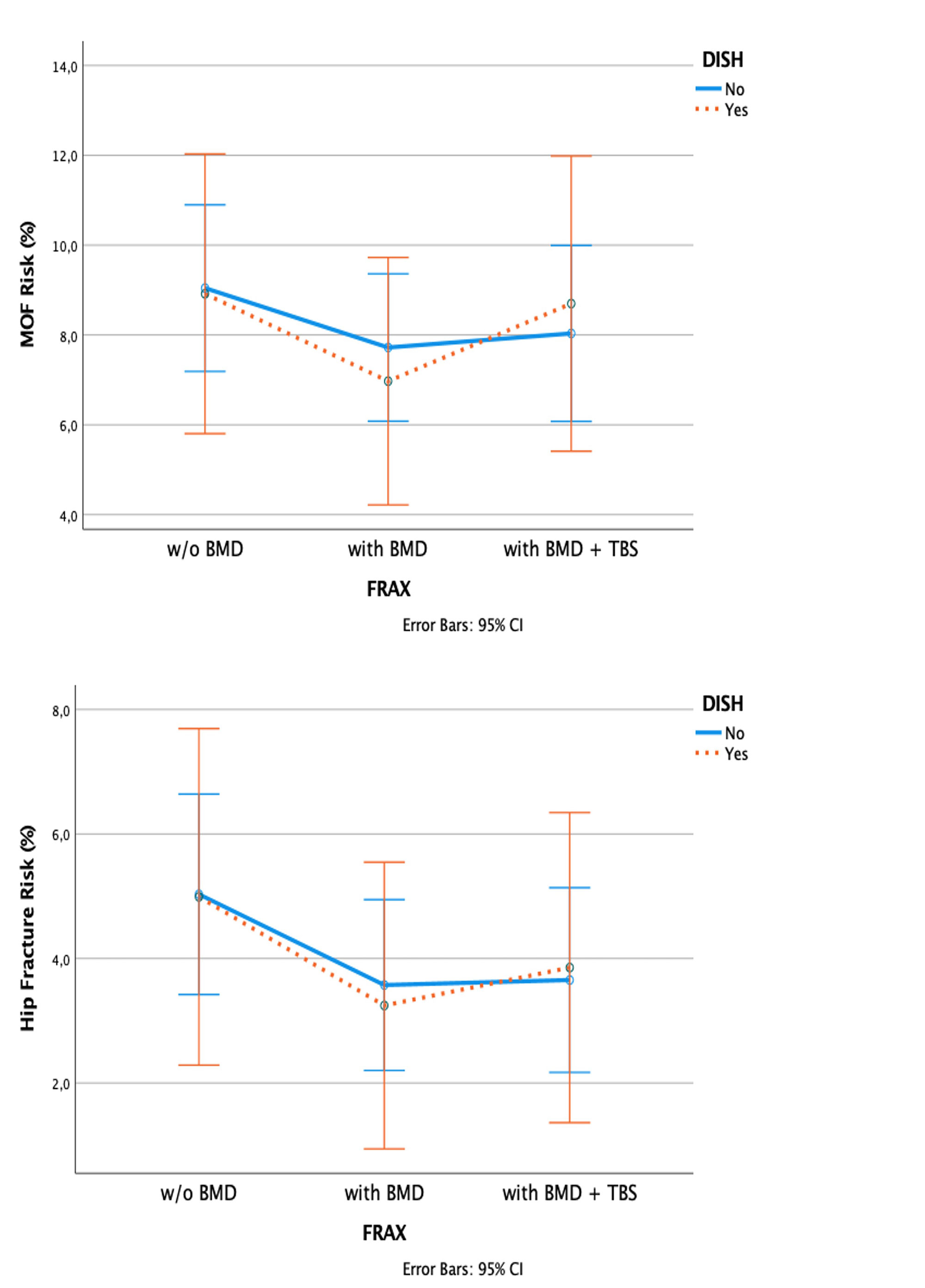Session Information
Date: Sunday, November 13, 2022
Title: Osteoporosis and Metabolic Bone Disease – Basic and Clinical Science Poster
Session Type: Poster Session C
Session Time: 1:00PM-3:00PM
Background/Purpose: Patients with rheumatic and musculoskeletal diseases (RMD) have an increased fracture risk (FxR). Diffuse idiopathic skeletal hyperostosis (DISH) is a non-inflammatory disease characterized by calcification and ossification of ligaments and entheses also reported to be associated with increased risk of vertebral fractures. However, DXA measured bone mineral density (BMD) is being falsely elevated by changes caused by DISH. Trabecular bone score (TBS) is said to be less affected by calcifications and degenerative changes. In this study we investigated whether TBS can improve FxR estimation in patients with RMD and DISH.
Methods: A subgroup of patients with RMD from a larger cohort (OsteoSys cohort) was analyzed, Patients aged 65 and older were recruited at a single tertiary hospital. DXA of the lumbar spine and hips was performed and TBS calculated. FRAX® major osteoporotic fracture (MOF) and hip fracture risk were calculated 1) without BMD, 2) with BMD and 3) with BMD and TBS. Available conventional X-Ray and computed tomography (CT)-scans of the spine and chest were used to diagnose DISH using the Resnick criteria. Student T-tests and Chi-Square statistics were used to examine differences between patients with and without DISH.
Results: A total of 153 patients (mean age 72.8 ± 5.4 years; 72.5% women) was included in the analysis. 20.9% had DXA T-scores ≤ -2.5 meeting WHO criteria for osteoporosis. Women had lower BMD and higher FRAX FxR. 19 patients (12.3%) fulfilled the criteria for DISH. DISH was significantly more common in men than in women (26.2% vs. 7.2%). BMD and T-scores were higher and FRAX FxR was lower in patients with DISH compared to controls whereas TBS was similar. Reported previous fractures and falls in the last 12 months were similar between groups. However, 0% of patients with DISH had osteoporosis by WHO criteria compared to 23.9% in the control group. For details see table. Adding BMD in the FRAX calculation decreased FxR in both groups whereas adding TBS to BMD numerically increased FRAX risk in men with DISH (see table and figure).
Conclusion: In this cohort patients with RMD and DISH report similar frequencies of previous fractures and falls compared to RMD patients without DISH. However, DISH patients had higher BMD (0% with T-score osteoporosis) and lower FRAX risk. TBS appears to improve FxR estimation in men with DISH but larger, prospective studies with fracture outcomes need to confirm this observation.
To cite this abstract in AMA style:
Buehring B, Kiefer D, Mueller C, Parvaee R, Ifanti M, Andreica I, Westhoff T, Wirth R, Baraliakos X, Babel N, Braun J. Is the Trabecular Bone Score (TBS) a Useful Tool in Patients with Diffuse Idiopathic Skeletal Hyperostosis (DISH)? [abstract]. Arthritis Rheumatol. 2022; 74 (suppl 9). https://acrabstracts.org/abstract/is-the-trabecular-bone-score-tbs-a-useful-tool-in-patients-with-diffuse-idiopathic-skeletal-hyperostosis-dish/. Accessed .« Back to ACR Convergence 2022
ACR Meeting Abstracts - https://acrabstracts.org/abstract/is-the-trabecular-bone-score-tbs-a-useful-tool-in-patients-with-diffuse-idiopathic-skeletal-hyperostosis-dish/



